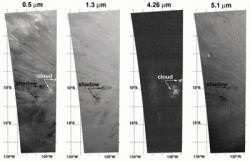Until now, Mars has generally been regarded as a desert world, where a visiting astronaut would be surprised to see clouds drifting across the orange sky. But new data and images show that Mars does indeed have clouds, and some are actually thick enough to cast a shadow on the planet’s surface. These are clouds of dry ice, or carbon dioxide (CO2), and sometimes they are so large and so dense that they throw quite dark shadows on the dusty surface. This, in turn, can affect the weather patterns on Mars. Researchers also say this discovery could help to understand Mars’ climate history.
Data obtained from ESA’s Mars Express OMEGA Visible and Infrared Mineralogical Mapping Spectrometer instrument has been analyzed by a group of French scientists.
“This is the first time that carbon dioxide ice clouds on Mars have been imaged and identified from above,” said Franck Montmessin of the Service da Aeronomie, University of Versailles. “This is important because the images tell us not only about their shape, but also their size and density.”
Clouds of water ice particles have previously been seen, for example on the sides of the giant Martian volcanoes. There have also been hints of much higher, wispy clouds made up of carbon dioxide (CO2) ice crystals. This is not too surprising, since the thin Martian atmosphere is mostly made of carbon dioxide, and temperatures on the fourth planet from the Sun often plunge well below the ‘freezing point’ of carbon dioxide. But these clouds are not very thick.
But the CO2 clouds detected by OMEGA are very different. Not only are they surprisingly high — more than 80 km above the surface — but they can be several hundred kilometers across. They are also much thicker than expected. Instead of looking like the wispy ice clouds seen on Earth, they resemble tall convectional clouds that grow as the result of rising columns of warm air.
Even more surprising is the fact that the CO2 ice clouds are made of quite large particles – more than a micron (one thousandth of a millimeter) across — and they are sufficiently dense to noticeably dim the Sun. Normally, particles of this size would not be expected to form in the upper atmosphere or to stay aloft for very long before falling back towards the surface.
“The clouds imaged by OMEGA can reduce the Sun’s apparent brightness by up to 40 per cent,” said Montmessin. “This means that they cast quite a dense shadow and this has a noticeable effect on the local ground temperature. Temperatures in the shadow can be up to 10 degrees C cooler than their surroundings, and this in turn modifies the local weather, particularly the winds.”
Since the CO2 clouds are mostly seen in equatorial regions, the OMEGA team believes that the unexpected shape of the clouds and large size of their ice crystals can be explained by the extreme variations in daily temperature that occur near the equator.
“The cold temperatures at night and relatively high day-time temperatures cause large diurnal waves in the atmosphere,” explained Montmessin. “This means there is a potential for large-scale convection, particularly as the morning Sun warms the ground.”
“This discovery is important when we come to consider the past climate of Mars,” Montmessin continued. “The planet seems to have been much warmer billions of years ago, and one theory suggests that Mars was then blanketed with CO2 clouds. We can use our studies of present-day conditions to understand the role that such high level clouds could have played in the global warming of Mars.”
Original News Source: ESA Press Release


Now if the rovers could a photo of a cloud shadow that would be awesome.